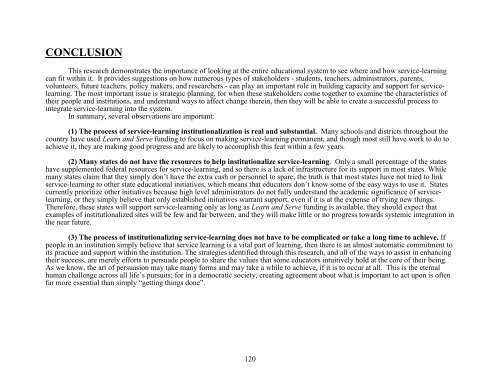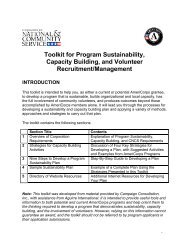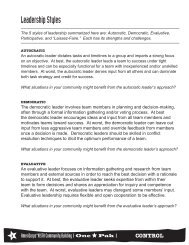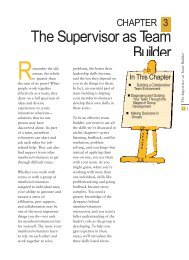MAKE IT LAST FOREVER: THE ... - National Service Resource Center
MAKE IT LAST FOREVER: THE ... - National Service Resource Center
MAKE IT LAST FOREVER: THE ... - National Service Resource Center
You also want an ePaper? Increase the reach of your titles
YUMPU automatically turns print PDFs into web optimized ePapers that Google loves.
CONCLUSION<br />
This research demonstrates the importance of looking at the entire educational system to see where and how service-learning<br />
can fit within it. It provides suggestions on how numerous types of stakeholders - students, teachers, administrators, parents,<br />
volunteers, future teachers, policy makers, and researchers - can play an important role in building capacity and support for servicelearning.<br />
The most important issue is strategic planning, for when these stakeholders come together to examine the characteristics of<br />
their people and institutions, and understand ways to affect change therein, then they will be able to create a successful process to<br />
integrate service-learning into the system.<br />
In summary, several observations are important:<br />
(1) The process of service-learning institutionalization is real and substantial. Many schools and districts throughout the<br />
country have used Learn and Serve funding to focus on making service-learning permanent, and though most still have work to do to<br />
achieve it, they are making good progress and are likely to accomplish this feat within a few years.<br />
(2) Many states do not have the resources to help institutionalize service-learning. Only a small percentage of the states<br />
have supplemented federal resources for service-learning, and so there is a lack of infrastructure for its support in most states. While<br />
many states claim that they simply don’t have the extra cash or personnel to spare, the truth is that most states have not tried to link<br />
service-learning to other state educational initiatives, which means that educators don’t know some of the easy ways to use it. States<br />
currently prioritize other initiatives because high level administrators do not fully understand the academic significance of servicelearning,<br />
or they simply believe that only established initiatives warrant support, even if it is at the expense of trying new things.<br />
Therefore, these states will support service-learning only as long as Learn and Serve funding is available, they should expect that<br />
examples of institutionalized sites will be few and far between, and they will make little or no progress towards systemic integration in<br />
the near future.<br />
(3) The process of institutionalizing service-learning does not have to be complicated or take a long time to achieve. If<br />
people in an institution simply believe that service learning is a vital part of learning, then there is an almost automatic commitment to<br />
its practice and support within the institution. The strategies identified through this research, and all of the ways to assist in enhancing<br />
their success, are merely efforts to persuade people to share the values that some educators intuitively hold at the core of their being.<br />
As we know, the art of persuasion may take many forms and may take a while to achieve, if it is to occur at all. This is the eternal<br />
human challenge across all life’s pursuits; for in a democratic society, creating agreement about what is important to act upon is often<br />
far more essential than simply “getting things done”.<br />
120










